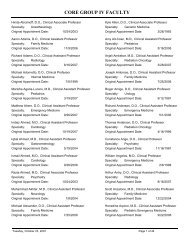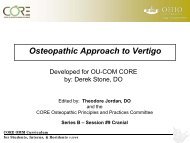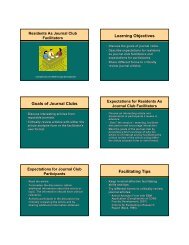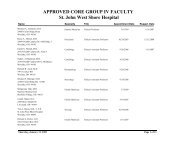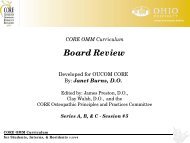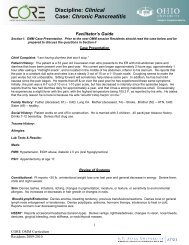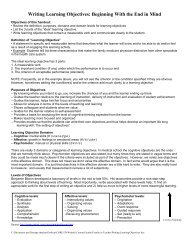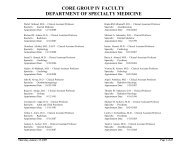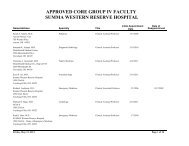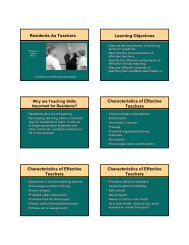CLINICAL Case: Postural Abnormality - Center for Osteopathic ...
CLINICAL Case: Postural Abnormality - Center for Osteopathic ...
CLINICAL Case: Postural Abnormality - Center for Osteopathic ...
You also want an ePaper? Increase the reach of your titles
YUMPU automatically turns print PDFs into web optimized ePapers that Google loves.
Discipline Area: <strong>CLINICAL</strong><br />
<strong>Case</strong>: <strong>Postural</strong> <strong>Abnormality</strong><br />
Facilitator’s Guide<br />
Section I: OMM <strong>Case</strong> Presentation. Prior to the next OMM session Residents should read the case below<br />
and be prepared to discuss the questions in Section II<br />
<strong>Case</strong> Presentation<br />
Chief Complaint: Left sided pain, greatest in lower extremity.<br />
Patient History: <strong>Osteopathic</strong> Manual Medicine outpatient clinic is consulted by Neurology service regarding a 67-yearold<br />
right handed female with a complaint of left sided pain that is greatest in the lower extremity. The pain is rated at a<br />
7, on a 0-10 pain scale. She describes the pain as slowly increasing in intensity over the last year. It is alleviated with<br />
pain medications and is exacerbated with walking and standing. She also reports left lower extremity swelling which has<br />
been unrelieved with diuretics and compression dressing. Per patient, Venous Doppler <strong>for</strong> deep venous thrombosis<br />
was negative in left lower extremity. Patient reports falling approximately one month ago in the middle of the night, and<br />
since that time she has been leaning to the right. Upon further questioning, she admits to falling at least once a week.<br />
She denies striking her head or loss of consciousness when falling, but states that she usually "catches" her foot, which<br />
causes the fall.<br />
Family History: Mother: cause of death unknown (at young age), Father: Myocardial infarction, Grandparents:<br />
unknown cause of death, no siblings, 2 grown sons both are healthy.<br />
Social History: Married, housewife, 2 grown children, denies any tobacco, alcohol or street drug use. 1-2 caffeinated<br />
beverages daily. Ranch-style home with 2 steps to enter.<br />
Allergies: Darvon (propoxyphene), sulfa drugs.<br />
Meds: Neurontin (gabapentin), Zoloft (sertraline), Amitriptyline, Lyrica (pregabalin), Oxycontin, OxyContin immediate<br />
release, Lasix (furosemide)<br />
PMH: Multiple Sclerosis (MS) diagnosed 11 years ago no recent exacerbations. Chronic constipation and incontinence<br />
related to MS, Cervical cancer, and right short leg <strong>for</strong> which she wears a 11mm shoe lift.<br />
PSH: Hysterectomy in 1989, bladder tack, denies any fractures. Patient does admit to occasional falls at home. Upon<br />
further questioning, she has been falling a couple of times per month due to right-sided weakness.<br />
Review of Systems<br />
Constitutional: Fatigue.<br />
Skin: Denies.<br />
Blood/Lymph/ Endocrine: Swelling & cold in extremities.<br />
ENT: Tinnitus.<br />
Eyes: Wears corrective lenses.<br />
Cardiovascular: Denies<br />
Pulmonary: Denies.<br />
GI: Constipation.<br />
GU: Urinary incontinence.<br />
Musculoskeletal: Frequent arthralgias in neck and hands.<br />
Neurologic: Cramping, numbness & tingling in hands & feet, and difficulty walking.<br />
Psychiatric: Denies anxiety, depression.<br />
CORE OMM Curriculum<br />
Residents 2009-2010<br />
1
Discipline Area: <strong>CLINICAL</strong><br />
<strong>Case</strong>: <strong>Postural</strong> <strong>Abnormality</strong><br />
Physical Exam<br />
Vitals: BP 98/60, HR 84, Resp 20, Ht 5'4", Wt 127, BMI 22.<br />
General: Thin, elderly appearing female in no acute distress, good hygiene.<br />
Eyes: Pupils equal, round & reactive to light and accommodation,<br />
extraocular muscles intact.<br />
ENT: Nares patent with pink mucosa, oral cavity moist without exudate or<br />
lesions noted, no lymphadenopathy palpated, tympanic membranes clear.<br />
CV: Regular rate & rhythm, pulses strong in all 4 extremities, left lower<br />
extremity with generalized non-pitting edema distally to mid-thigh, negative<br />
Homan's sign.<br />
Respiratory: Clear to auscultation bilaterally.<br />
GI: Abdomen soft, non-tender, no masses or hepatosplenomegaly<br />
palpated, normal active bowel sounds.<br />
GU: Deferred.<br />
Musculoskeletal: 5/5 manual muscle testing of bilateral upper & lower<br />
extremities in all major muscle groups <strong>for</strong> patient's age. Range of<br />
motion of shoulder & hip girdles within functional limits.<br />
Motor: fine finger movements better on the left.<br />
Neurologic: Alert & oriented x 3, normal affect, cranial nerves II-XII intact,<br />
nystagmus on upgaze, deep tendon reflexes 3+/4+ in left upper and<br />
bilateral lower extremities, 2+/4+ right upper extremity. Hoffman's sign<br />
positive at the left hand, Sensory decreased to light touch on the left arm &<br />
leg, allodynia of both arms. Mild spasticity of both lower extremities.<br />
Gait: Ambulates with single point cane held in right hand <strong>for</strong> ambulatory<br />
assistance, narrow based stance with mild-moderate scissoring, head<br />
flexed, looking at floor, increased sidebending at the waist causing listing to<br />
right.<br />
OMM Focused Structural Exam<br />
Posture: Head tilted left, increased<br />
thoracic kyphosis, internal rotation at the<br />
shoulder girdle, anterior head carriage,<br />
listing to right with standing & sitting.<br />
Right sidebending at waist<br />
increases when patient ambulates<br />
or closes eyes. When patient is<br />
placed in a standing upright<br />
position, she feels off balance &<br />
"crooked", immediately resuming<br />
right sidebending. OA ESrLl, C3<br />
ERSr, C7 FRSr, T1-2 F RSr, T6-9<br />
NRlSr,<br />
Right anterior innominate rotation,<br />
Left anterior fibular head, bilateral<br />
sacral restriction, bilateral<br />
paraspinal musculature tightness<br />
of the cervical, thoracic and lumbar<br />
spine.<br />
Rib 9 on the right was exhaled;<br />
Ribs 2,4,7 were exhaled on the left<br />
with restricted motion of the left<br />
lower rib cage, bilateral tight<br />
hamstrings, iliopsoas and a left<br />
piri<strong>for</strong>mis tender point.<br />
Assessment:<br />
Leg pain/edema: venous thrombosis,<br />
venous varicosities, and lymphatic<br />
obstruction in groin/pelvic region on left by<br />
space occupying mass, occult hip/leg<br />
fracture.<br />
<strong>Postural</strong> abnormality: CVA in<br />
cerebellum, fall, worsening spasticity due<br />
to multiple sclerosis, visual disturbance,<br />
canalithiasis (dislodged otolith), occult hip<br />
fracture. Weak hip extensors, tight hip<br />
flexors.<br />
CORE OMM Curriculum<br />
Residents 2009-2010<br />
2
Discipline Area: <strong>CLINICAL</strong><br />
<strong>Case</strong>: <strong>Postural</strong> <strong>Abnormality</strong><br />
Section II: Focus of the <strong>Case</strong> (approximate time 20–30 minutes)<br />
Discussion Questions<br />
1. Propose an appropriate differential<br />
diagnosis / assessment<br />
2. What is your final diagnosis<br />
3. How do you explain the current<br />
structural findings in the context of<br />
this case<br />
<br />
<br />
Are any relevant structural findings<br />
missing<br />
What would you do differently<br />
Teaching Points<br />
Differential Diagnoses:<br />
1. Leg pain/edema: venous thrombosis, venous varicosities, and<br />
lymphatic obstruction in groin/pelvic region on left by space occupying<br />
mass, occult hip/leg fracture.<br />
<strong>Postural</strong> abnormality: CVA in cerebellum, fall, worsening spasticity due to<br />
multiple sclerosis, visual disturbance, canalithiasis (dislodged otolith),<br />
occult hip fracture. Weak hip extensors, tight hip flexors.<br />
<br />
<br />
Primary Diagnosis: E888 Accidental fall.<br />
Secondary Diagnosis: 340 Multiple sclerosis, and 788.30 Urinary<br />
incontinence.<br />
Somatic dysfunction related to diagnosis: 739.0 Head, 739.1<br />
Cervical, 739.2 Thoracic, 739.3 lumbar, 739.4 Sacrum/Sacroiliac,<br />
739.5 Hip/Pelvis, 739.6 Lower Extremity, and 739.8 Rib.<br />
Most of the patients structural examination findings are compensatory, to<br />
maintain her in an upright position, over a center of gravity that was<br />
deviated to the right. Her tight paraspinal muscles maintained her in a<br />
coronal plane, attempting to compensate <strong>for</strong> the rotation and side-bending<br />
somatic dysfunction palpated in the spinal column.<br />
<br />
Why<br />
4. What pathophysiology & functional<br />
anatomy knowledge is pertinent <strong>for</strong><br />
diagnosing/treating this patient<br />
<br />
<br />
<br />
<br />
<br />
<br />
<strong>Postural</strong> imbalance & gait instability are particular issues with<br />
geriatric patients.<br />
Peripheral sensory input significantly provides <strong>for</strong> the maintenance<br />
of upright posture.<br />
Aging is associated with a decrease in postural balance that<br />
increases the risk of falling. When a patient falls, they tend to fall<br />
to the side, fracturing a hip. As the person ages, visual,<br />
labyrinthine & somatosensory inputs change their contribution to<br />
the dynamic maintenance of standing posture.<br />
Upper thoracic flexion & decreased cervico-occipital extension<br />
affect head position, lowering the visual field from the horizon &<br />
shifting the neutral position of the vestibular apparatus.<br />
The head-flexed position significantly increases postural<br />
instability. The loss of muscle mass & strength associated with<br />
aging impairs compensation. The patient's history of multiple<br />
sclerosis greatly impacts her strength, balance, proprioception and<br />
visual acuity. This places her at a higher risk of falling and<br />
fracturing a hip or sustaining a closed head injury.<br />
Urinary incontinence also places the patient at a greater risk of<br />
falling.<br />
CORE OMM Curriculum<br />
Residents 2009-2010<br />
3
Discipline Area: <strong>CLINICAL</strong><br />
<strong>Case</strong>: <strong>Postural</strong> <strong>Abnormality</strong><br />
5. What will be your highest yield<br />
regions<br />
6. How does previous trauma influence<br />
these regions<br />
Indirect Myofascial release of the truncal muscles would be the<br />
highest yield. Muscle energy techniques may worsen spasticity. No<br />
standing techniques due to risk of a fall. Exercise caution when<br />
transitioning patient from supine to standing due to risk of dizziness &<br />
fall risk.<br />
Patient denies any fracture history, but has been falling frequently<br />
which may result in hip or vertebral compression fracture or closed<br />
head injury.<br />
7. Which 1 or 2 of the aspects below has<br />
the greatest influence on the patient<br />
complaint<br />
Pain<br />
Fluid congestion<br />
Hyper-sympathetic influence<br />
Pain and fluid congestion of the left lower extremity is what brought her to<br />
our clinic, but both are due to postural abnormalities.<br />
Normally parasympathetics could be a cause of urinary incontinence<br />
and constipation, but with the patient's history of Multiple Sclerosis,<br />
her bowel and bladder issues are central in nature. A hysterectomy<br />
may also cause incontinence, but not in this patient's case.<br />
Parasympathetic influence<br />
8. What are the acute or chronic aspects Acute: Risk of falling and fracture or head injury due to postural<br />
abnormality.<br />
9. Devise an appropriate treatment plan<br />
based on musculoskeletal components<br />
involved in the patient complaint<br />
10. How soon would you see the patient<br />
<strong>for</strong> OMM follow-up<br />
11. What are the outpatient, inpatient, and<br />
emergency room considerations<br />
Chronic: Worsening of multiple sclerosis<br />
Goals <strong>for</strong> osteopathic manipulative management—includes:<br />
Lengthen hamstrings, iliopsoas muscles, strengthen hip extensors, and<br />
improve proprioception and balance. Recheck postural type. Radiologic<br />
studies to re-evaluate right short leg to ensure proper lift height. Caution<br />
should be used, not to fatigue, or over heat the patient, both of which can<br />
worsen weakness associated with multiple sclerosis.<br />
The treatment plan could include:<br />
Indirect Myofascial release to the truncal musculature, balanced<br />
ligamentous tension applied to innominate, fibula and sacrum.<br />
Articulatory techniques or facilitated positional release to the cervical<br />
spine, ribs and tight muscle groups.<br />
<br />
Also instruct patient to check self frequently in mirror to encourage<br />
upright posture.<br />
The geriatric population has a relatively strong response to relatively little<br />
stress and may have a rebound reaction to OMT. She may feel more<br />
fatigued, or have increased pain. This may last <strong>for</strong> 12 to 48 hours. The<br />
patient should be given 3 days to 2 weeks between OMT interventions to<br />
allow the body to come to a new homeostatic point.<br />
She is being seen as an outpatient, there<strong>for</strong>e, see above.<br />
As an inpatient <strong>for</strong> a non-related illness, she may decompensate easier<br />
and become weaker quicker due to her Multiple sclerosis.<br />
If presenting to the ER with a sudden increase in loss of balance,<br />
weakness or vision change, she should be evaluated <strong>for</strong> a CVA or<br />
exacerbation of multiple sclerosis.<br />
CORE OMM Curriculum<br />
Residents 2009-2010<br />
4
Discipline Area: <strong>CLINICAL</strong><br />
<strong>Case</strong>: <strong>Postural</strong> <strong>Abnormality</strong><br />
12. How are you going to talk to your<br />
patient about their complaint and your<br />
treatment<br />
12 Continued...<br />
Educate about decreasing fall risk in the home. Educate about postural<br />
imbalance and indirect treatment approach be<strong>for</strong>e per<strong>for</strong>ming techniques.<br />
After OMT is per<strong>for</strong>med, prescribe physical therapy to continue working<br />
with patient <strong>for</strong> strengthening of hip extensors, balance and<br />
proprioception, as short-term goals. Long-term goals could be initiation of<br />
daily walking program, weight lifting with very light weights and stretching<br />
of large muscle groups to maintain range of motion.<br />
13. How will you communicate your<br />
findings, diagnosis, and rationale <strong>for</strong> OMM<br />
treatment to your preceptor<br />
14. What coding and billing in<strong>for</strong>mation <strong>for</strong><br />
evaluation and management and<br />
procedural services will you generate<br />
The pertinent positive and negative findings from the history and physical<br />
will be presented. Treatment options will be discussed. Long term<br />
management and consultation requirements will be discussed. Any<br />
questions will be addressed at this time.<br />
E/M- 99244 Comprehensive – Mod.<br />
Diagnosis- E888 Accidental fall, 340 Multiple sclerosis, and 788.30<br />
Urinary incontinence, 739.0 head, 739.1 cervical, 739.2 thoracic, 739.4<br />
sacral/sacroiliac, 739.5 hip/pelvic, 739.6 lower extremity, 739.8 rib.<br />
Procedure codes- 98928 Manipulation 7-8 areas.<br />
15. How would you record your encounter<br />
and OMT on your patient care logs<br />
Enter patient data, diagnosis date, and any special comments.<br />
Procedure Services:<br />
<strong>Osteopathic</strong> Manipulative Treatment<br />
Code<br />
Description<br />
98925 Manipulation, 1-2 areas<br />
98926 Manipulation, 3-4 areas<br />
98927 Manipulation, 5-6 areas<br />
X 98928 Manipulation, 7-8 areas<br />
98929 Manipulation, 9-10 areas<br />
CPT Diagnostic Codes: Rank in order of Importance<br />
Diagnosis<br />
Somatic Dysfunction<br />
Code Description Code Description Code Description<br />
788.30 Urinary<br />
Incontinence<br />
739.0 Head 739.5 Hip/Pelvis<br />
739.1 Cervical 739.6 Lower<br />
Extremity<br />
739.2 Thoracic 739.7 Upper<br />
Extremity<br />
739.3 Lumbar 739.8 Rib<br />
739.4 Sacrum/Sacroiliac 739.9 Abdomen<br />
CORE OMM Curriculum<br />
Residents 2009-2010<br />
5
Discipline Area: <strong>CLINICAL</strong><br />
<strong>Case</strong>: <strong>Postural</strong> <strong>Abnormality</strong><br />
16. Evidence-Based Medicine (EBM) is the integration of best research evidence with clinical expertise and patient<br />
values, consistent with the legacy of Andrew Taylor Still “To improve the practice of medicine by understanding the true<br />
nature of the human patient” (Robert C. Davies, 2001). Evidence is found after appropriate search and a critical<br />
appraisal of the clinical and research evidence. The patient is educated about the evidence <strong>for</strong> the management chosen,<br />
but ultimately the physician will affirm the course of treatment based on clinical experience, patient’s values and<br />
evidence available.<br />
Search <strong>for</strong> the best evidence references:<br />
An appraisal of the osteopathic literature is critical to ensure the osteopathic paradigm is <strong>for</strong>emost in the philosophical<br />
application of in<strong>for</strong>mation to patient care. Search of relevant and associated data from the osteopathic literature:<br />
OstMed-Dr (http://www.ostmed-dr.com:8080/vital/access/manager/Index)<br />
Other literature bases (systems or synopsis engines):<br />
Poems (www.infopoems.com)<br />
Family Practice Inquiry Network (www.fpin.org)<br />
<br />
<br />
PubMed<br />
Ovid<br />
<br />
Google Scholar<br />
Section III: Workshop/Lab (approximate time 60 minutes)<br />
Facilitator demonstrates the key treatment techniques.<br />
1. Participants divide into groups at the table<br />
2. At each table, discuss and practice the appropriate palpatory diagnosis <strong>for</strong> this patient<br />
3. Facilitator demonstrates the key treatment techniques:<br />
4. Participants should practice the following techniques on each other:<br />
<br />
<br />
Indirect Myofascial release to the truncal musculature, balanced ligamentous tension applied to innominate, fibula<br />
and sacrum.<br />
Articulatory techniques or facilitated positional release to the cervical spine, ribs and tight muscle groups.<br />
5. At each table, while the techniques are being practices:<br />
6. Documentation<br />
a. Identify and practice good body mechanics <strong>for</strong> the physician and patient in treatment<br />
b. Discuss the treatment plan<br />
c. Discuss what palpatory findings should change on the patient after OMM treatment<br />
Residents demonstrate an appropriate documentation of this case including findings and treatment here...<br />
CORE OMM Curriculum<br />
Residents 2009-2010<br />
Section IV: Final Wrap-up and Questions/Answers<br />
6





